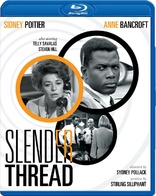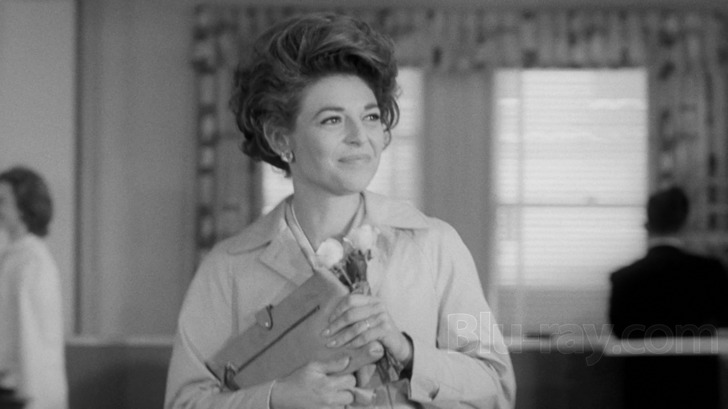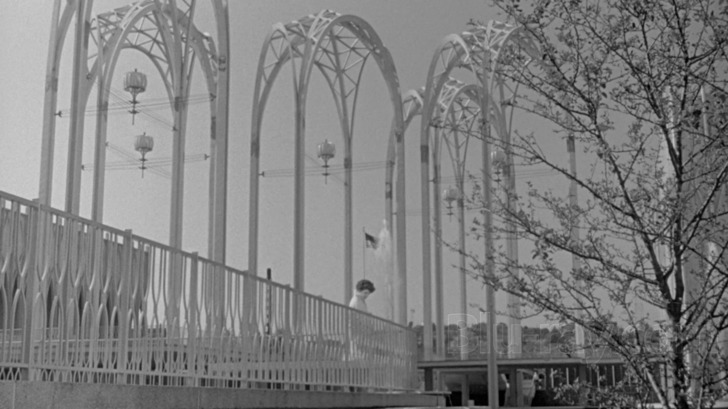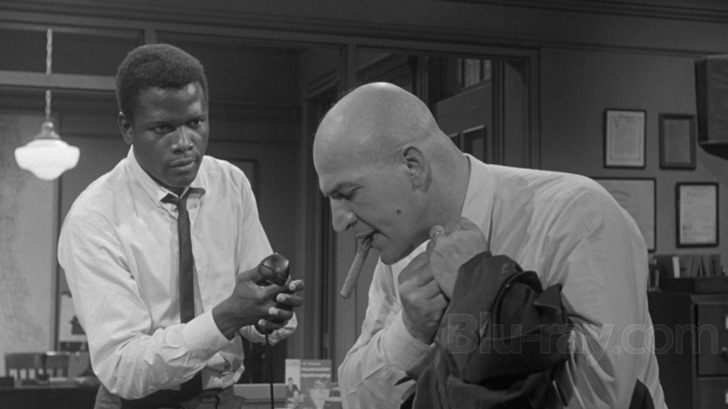The Slender Thread Blu-ray Movie
HomeThe Slender Thread Blu-ray Movie 
Olive Films | 1965 | 99 min | Not rated | Oct 16, 2012
Movie rating
6.8 | / 10 |
Blu-ray rating
| Users | 0.0 | |
| Reviewer | 4.0 | |
| Overall | 4.0 |
Overview
The Slender Thread (1965)
Alan is a Seattle college student volunteering at a crisis center. One night when at the clinic alone, a woman calls up the number and tells Alan that she needs to talk to someone. She informs Alan she took a load of pills, and he secretly tries to get help. During this time, he learns more about the woman, her family life, and why she wants to die. Can Alan get the cavalry to save her in time before it's too late?
Starring: Sidney Poitier, Anne Bancroft, Telly Savalas, Steven Hill, Edward AsnerDirector: Sydney Pollack
| Drama | 100% |
Specifications
Video
Video codec: MPEG-4 AVC
Video resolution: 1080p
Aspect ratio: 1.78:1
Original aspect ratio: 1.85:1
Audio
English: DTS-HD Master Audio Mono
Subtitles
None
Discs
25GB Blu-ray Disc
Single disc (1 BD)
Playback
Region A (B, C untested)
Review
Rating summary
| Movie | 4.0 | |
| Video | 4.0 | |
| Audio | 3.5 | |
| Extras | 0.0 | |
| Overall | 4.0 |
The Slender Thread Blu-ray Movie Review
The fraying of a human psyche.
Reviewed by Jeffrey Kauffman October 15, 2012If, as the old saying (which originated with none other than Benjamin Franklin) goes, the only two things of which we can be certain are death and taxes, a perhaps puckish auxiliary question might be asked: would you ever think of paying your taxes ahead of time? Probably not, which leads to a second quandary: what could ever lead someone to take their own life, when it’s obvious our built in mortality is going to take care of that “problem” sooner or later, anyway? Suicide remains one of the more baffling traits of humans, and perhaps no “outsider” can ever fully understand the reasons that would lead someone else to kill themselves. My own family was rocked with the suicide of an Aunt of mine (long before I was born), and though her siblings—including my father—haltingly tried to tie her decision to a childhood spent in foster care, it never really completely addressed the depression that must have colored her emotional being, especially since my father and his other siblings were also shunted around from foster home to foster home as they grew up and managed (for the most part, anyway) to “escape” unscathed, forging extremely successful personal and professional lives. But suicide is a rather rampant if frequently ignored epidemic, as the placard emblazoned across the wall of a call-in help line in Sydney Pollack’s directorial debut The Slender Thread makes clear: “Every two minutes someone attempts suicide in the United States”. It’s a staggering statistic and one that brings a certain sense of urgency to this well meaning if soap operatic look at a woman in distress who reaches out to someone—anyone—after a perhaps irreversible decision she’s made to end her own life.

Stirling Silliphant had one of the more fascinatingly diverse writing careers in television and film history. Silliphant started his career on the advertising side of things, perhaps figuring out early what would sell, and his early television career saw him churning out episodic television for any number of huge hits of the day, including The Mickey Mouse Club, Alfred Hitchock Presents and Perry Mason. He made his feature film writing debut with the well regarded Village of the Damned in 1960, still one of the most iconic science fiction films of its era. Silliphant continued to work for television throughout the sixties, but also contributed screenplays for a hugely disparate array of films. The Slender Thread came along in 1965, followed by what is arguably Silliphant’s most lasting achievement and the film for which he won the Academy Award, In the Heat of the Night. Silliphant’s post- Heat career saw him tackling everything from Cliff Robertson’s Oscar winning film Charly to two of the most legendary disaster films of all time, The Poseidon Adventure and The Towering Inferno. An oeuvre such as this might suggest that Silliphant had no intrinsic point of view and might be best understood as a “hired gun”, but the fact is virtually every screenplay of his pays special attention to character, and that’s certainly the case in The Slender Thread, where the slow peeling back of layers of suicidal Inga (Anne Bancroft) allows the viewer to at least approach an appreciation of why she would have taken such a drastic step.
Sidney Poitier portrays University of Washington student Alan Newell, an anthropology major (at least if one goes by the book he rather cheekily attaches to a clipboard next to his steering wheel so that he can read while driving) who also volunteers at the local Crisis Center help line. He arrives one night to see resident psychiatrist Dr. Coburn (Telly Savalas, sucking on a stogie instead of Kojak’s lollipop) leaving for the evening and promising Alan a quiet night. That of course turns out not to be the case. First Alan gets a funny call from an angry barber who is feeling the weight of the world on his tonsorial shoulders, but soon things turn decidedly more serious when Inga calls, announcing that she’s downed a lethal dose of barbiturates. Alan, all alone at the crisis center, has to figure out how to make a connection with Inga that will keep her on the line while he simultaneously does his best to get help to the center which will aid him in finding the hapless woman.
Silliphant and Pollack manage to work up a considerable amount of suspense even though The Slender Thread is by its very nature easily one of the talkiest dramas of its era. Virtually the entire film is framed via the ongoing conversation between Alan and Inga. Alan’s center has a speaker system which allows him to have Inga’s call ported over to the speaker system, so much of the film shows the character just kind of loosely hanging on the phone, barely even speaking into it at times. It’s overly theatrical and is one of the few elements in the film that doesn’t seem to ring true. In terms of the suspense factor, a running subplot has the then high tech wizards at what must have been Bell Telephone jumping through various hoops to try to trace the call. This part of the film is an interesting study in dichotomy: it’s a fascinating element of the film, but it instantly places the film in the “distant” past with its now archaic technology.
A number of other characters are introduced, including Steven Hill (Mission: Impossible, Law and Order) as Inga’s husband, whose discovery of a long ago indiscretion starts the woman off on a depressive path (though there are indications she was a troubled soul before this revelation disrupts her marriage). Edward Asner is also on hand as one of the policemen who are tasked with finding Inga. That allows the film to break out of the confines of Alan’s Crisis Center and Inga’s flashback locales, and Pollack very handily utilizes some fantastic Seattle location footage that really helps to localize the drama.
There is no denying that The Slender Thread skirts with outright soap operatic elements with regard to Inga’s disintegrating marriage. To the film’s credit, however, neither Bancroft nor Hill devolve into histrionics, and indeed it’s the couple’s very tamped down emotional nature that gives the film much of its inherent power. This is a showcase for Bancroft, who handles the transition from guilt to depression to thoughts of suicide incredibly well. Hill manages to invest his character with some very nimble ambiguity—Mark probably wants to forgive his wife, but can’t quite figure out how to get there. Poitier’s role is rather interesting. It’s a strange mixture of passivity with snippets of bizarre aggression, but Poitier is such an appealing, almost intrinsically heroic, presence that the shortcomings of any character development are subsumed by Poitier’s always visceral acting style.
The Slender Thread Blu-ray Movie, Video Quality 

The Slender Thread is presented on Blu-ray courtesy of Olive Films with an AVC encoded 1080p transfer in 1.78:1. This is yet another really nice looking black and white release culled from the Paramount archives and released by Olive. The elements here do have sporadic damage, including some reel markers, scratches and one bizarre moment of dots superimposed over the bulk of the image. There is also one moment of what appears to have been a slipped frame, when the image "jumps" just a little bit. Other than those anomalies, though, Loyal Griggs' cinematography is presented with excellent clarity and good (if not really exceptional) contrast. The second unit photography often looks just a tad softer than the more studio bound footage.
The Slender Thread Blu-ray Movie, Audio Quality 

The Slender Thread features a lossless DTS-HD Master Audio Mono mix that gets the job done but which never really explodes into anything very sonically remarkable. One of the most interesting aspects to the film is its score by Seattlite Quincy Jones, one of his very earliest feature film outings. Jones modulates between straight orchestral backing and some jazz figurings that presage some his cool television themes of the mid-sixties. The score isn't especially cohesive for this very fact, but it sounds fantastically vibrant in this lossless setting. The rest of the film is really limited to dialogue scenes, with only a couple of sequences even offering much in the way of ambient environmental sounds. Fidelity is fine and dynamic range is about what you'd expect in a dramatic film like this.
The Slender Thread Blu-ray Movie, Special Features and Extras 

No supplements of any kind are included on this Blu-ray disc.
The Slender Thread Blu-ray Movie, Overall Score and Recommendation 

It's kind of interesting that The Slender Thread never really was a huge theatrical blockbuster, despite the fact that both its stars had at that time fairly recently won Best Actor and Actress Academy Awards. The film was probably too intimate and perhaps was hobbled by being shot in black and white which by 1965 was a dying commodity. Seen in retrospect now, however, The Slender Thread provides Bancroft especially with a field day, and she delivers a really moving, wonderfully nuanced performance. If the call tracing "technology" on display is almost laughable by today's standards, it still provides a fascinating historical glimpse into the milieu of the film. It can't really be said that The Slender Thread is a feel good movie, despite its quasi-happy ending, but at least it helps to deliver a riveting story about those who keep the "attempts" in the suicide statistic quoted above (and seen in the first screencap) from becoming "succeeds". Recommended.
Similar titles
Similar titles you might also like

A Thousand Clowns
1965

The Paper Chase
1973

Fahrenheit 11/9
2018

I Am Not Your Negro
2016

Where to Invade Next
2015

Drunk Stoned Brilliant Dead: The Story of the National Lampoon
2015

Best of Enemies
2015

Corman's World: Exploits of a Hollywood Rebel
2011

Waiting for "Superman"
2010

Stephen Fry in America
2007

The Offer
2022

Brief Encounter
1974

Class Action
1991

The Long Dumb Road
2018

And the Band Played On
1993

Nostalgia
2018

7 Women
Warner Archive Collection
1966

Nobody Walks
2012

The Men's Club
1986

I Am Chris Farley
2015